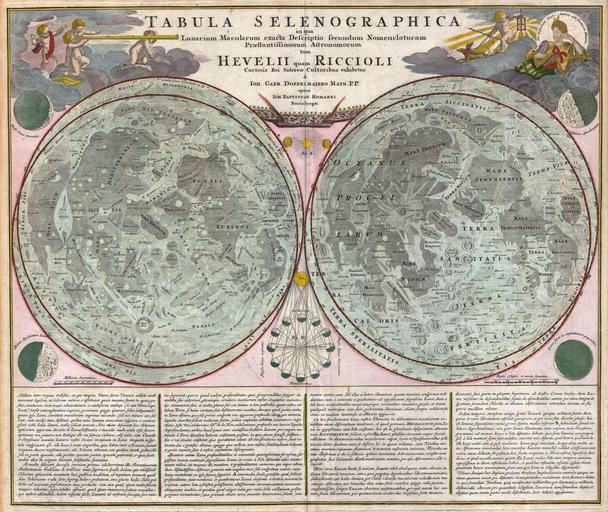MAKE A MEME
View Large Image

| View Original: | 1707_Homann_and_Doppelmayr_Map_of_the_Moon_-_Geographicus_-_TabulaSelenographicaMoon-doppelmayr-1707.jpg (4000x3367) | |||
| Download: | Original | Medium | Small | Thumb |
| Courtesy of: | commons.wikimedia.org | More Like This | ||
| Keywords: 1707 Homann and Doppelmayr Map of the Moon - Geographicus - TabulaSelenographicaMoon-doppelmayr-1707.jpg A stunning full color example of J B Homann and Johann Gabriel Doppelmayr ™s important c 1742 map of the Moon Essentially a comparative chart Doppelmayer constructed this map to illustrate the lunar mapping of Johannes Hevelius left and Giovanni Battista Riccioli right The left hand lunar map composed by Hevelius is a considered a foundational map in the science of Selenography “ or lunar cartography This map first appeared in Hevelius ™ 1647 work Selenographia which laid the groundwork for most subsequent lunar cartographic studies Here the moon is presented as it can never be seen from Earth at a greater than 360 degrees and with all visible features given equal weight In this map Hevelius also establishes the convention of mapping the lunar surface as if illuminated from a single source “ in this case morning light The naming conventions he set forth which associate lunar features with terrestrial locations such as Asia Minor Persia Sicilia and etcetera were popular until the middle of the 18th century when Riccioli ™s nomenclature took precedence The Riccioli map on the right is more properly known as the Riccioli-Grimaldi map for the fellow Jesuit Francesco Grimaldi with whom Riccioli composed the chart This map first appeared in Riccioli and Grimaldi ™s 1651 Almagestum Novum This was a significant lunar chart and offered an entirely new nomenclature which for the most part is still in use today Curiously though Riccioli as a devout Jesuit composed several treatises denouncing Copernican theory he chose to name one of the Moon ™s most notable features after the astronomer “ perhaps suggesting that he was a secret Copernicus sympathizer Other well-known lunar features named by Riccioli include the Sea of Tranquility where Apollo 11 landed and where Neil Armstrong became the first human to set foot on the moon ™s surface The upper left and right hand quadrants feature decorative allegorical cartouche work that include images of angelic children looking through a telescope and a representation of the ancient Greek Moon goddess Selene Additional mini-maps show the moon in various phases of its monthly cycle Below the map proper extensive Latin text discusses Selenography This map first appeared in J B Homann ™s 1707 Neuer Atlas and was later reissued as plate no 11 in Doppelmayr ™s important 1742 Atlas Coelestis which was also published by the Nuremburg firm of Johann Baptist Homann There is no discernable difference between the two issues and it is all but impossible to know in which of the two publications this map was drawn from or 1707 1742 undated Size in 23 20 object history credit line accession number TabulaSelenographicaMoon-doppelmayr-1707 Homann J B Neuer Atlas bestehend in auserlesenen und allerneusten Land-Charten ueber die gantze Welt und zwar erstlich nach Astronomischer Betrachtung der Bewegung des Himmels in dem Systemate Copernico-Hugeniano dann auch nach der nturlichen Beschaffenheit und geographischen Eintheilung der mit Wasser umgebenen allgemeinen Erd-Kugeln in ihre besondere Monarchien Koenigreiche Staaten und Laender Nuremberg 1707 Also in Doppelmayr J G Atlas Coelestis in quo Mundus Spectabilis et in eodem Stellarum omnium Phoenomena notabilia circa ipsarum Lumen Figuram Faciem Motum Eclipses Occultationes Transitus Magnitudines Distantias aliaque secundum Nic Copernici et ex parte Tychonis de Brahe Hipothesin Nostri intuitu specialiter respectu vero ad apparentias planetarum indagatu possibiles e planetis primariis et e luna habito generaliter e celeberrimorum astronomorum observationibus graphice descripta exhibentur cum tabulis majoribus Homann Nurenburg 1742 Geographicus-source PD-Art-100 1707 maps Mondkarte Homann Old maps of the Moon 1707 Homann Johann Baptist Homann Mondkarte Maps in Latin Homann Mondkarte Johann Gabriel Doppelmayr Mondkarte | ||||